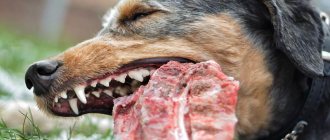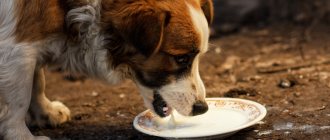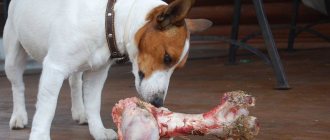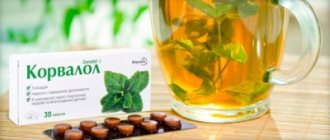The birth of puppies is an event for which you need to carefully prepare. One of the important factors in the growth process of an animal is nutrition. Owners should familiarize themselves with the feeding habits of newborn puppies in order to minimize the development of gastrointestinal diseases. You can find out what to feed one-week-old and one-month-old puppies from the article.
Feeding small puppies
Basic feeding rules
How to feed a puppy from birth without a mother is a common question for dog lovers who are faced with their offspring refusing mother’s milk. When choosing a diet for dogs, it is necessary to take into account some important conditions that veterinarians note:
- babies need to be fed at the same time every day;
- food for animals should be warm, but not hot;
- after eating food, it is worth postponing active games so that the food is absorbed in the body;
- Puppies need clean, plain water. Therefore, they must have access to it constantly.
- It is not recommended to mix dry food with natural food. If initially the offspring ate natural food, and now the owner wants to introduce purchased food into their diet, then it is worth discussing this issue with a veterinarian. A sudden transition to a new food can trigger the development of stomach diseases;
- the use of salt should be kept to a minimum;
- Artificial feeding of puppies takes place using special baby food enriched with vitamins, minerals, and microelements.
Important! The main rule of feeding puppies of any breed (Yorkie, Bulldog, German Shepherd, French Spitz, Husky, Chihuahua, Terrier) is to fill the diet with vitamins and amino acids for full development.
Nutrition for babies from 2 months
FEEDING PUPPIES
There can be many reasons for artificial feeding. For example, if a bitch has had a caesarean section, milk may not come immediately, but only after a few days. If the operation was accompanied by complications, drugs could be used in which feeding puppies with mother's milk is contraindicated. You should not feed puppies to a bitch with inflammation of the uterus, if the milk is toxic to the puppies or if the mother has signs of eclampsia. There are weak or small puppies that can be saved if they do not have congenital defects or diseases, or large litters in which the puppies need early complementary feeding. There have been cases when a bitch died in childbirth - unfortunately, this cannot be ruled out either. I'll tell you about my experience.First: before giving birth, it is better to buy a bitch's milk substitute - just in case. Dogs tend to give birth at the most inopportune times - for example, at night, when finding a substitute for the bitch's milk may be unrealistic. Nowadays several companies make milk for puppies. It is difficult to say which one is suitable in your case - everything is very individual. The first milk we bought was from Beafar - it is sold in almost all pet stores. I diluted it according to the instructions, tried to give it to puppies through a pacifier, and through a pipette, and through a syringe - it simply did not suit us. I didn’t like the look - it was watery, but the puppies didn’t like the taste. They refused to drink it, spitting and crying (although I know a breeder who raised litters on Beafar milk and had poor results with Royal Canin). Already in the morning we were able to get a can of Royal Canin milk. It fit perfectly. Pros: The kit includes a bottle with three nipples. If you are feeding puppies artificially, it is better to prepare some medicine for sore tummies in advance - there is a high probability that the transition to a new product may be unpleasant. I prefer to give soft plantex to newborn babies. The sachet is diluted in water and dispensed a little at a time (0.5-1 ml) from a syringe after meals. This remedy actually works.
Cow's milk is not suitable for feeding puppies - it contains 2 times less calories and essential nutrients. Goat's milk is better for feeding, but a little honey and a quail egg are added to it.
It’s not easy with bottles: the manufacturer suggests that for small puppies of medium-sized breeds, start with the smallest nipple. All attempts to feed the puppies from it failed. Its tip is too narrow and long, and the rubber is too hard - a small puppy cannot squeeze anything out of it, the milk simply does not flow. And it doesn’t squeeze out if you try to help the puppy with your hands. The best results were with the largest size nipple - it is the size and shape of a corgi nipple, and it is soft, even with not very strong pressure, milk comes out of it. It took me a while to figure out exactly how the Royalcanin nipple worked, and at first I found it uncomfortable. The instructions are written very abstractly, and it is not very easy to guess what exactly the creators of this product had in mind. On the nipple itself there are marks - “rounds”, small, medium, and large. So, if you hold the bottle with the small round side up, it is most difficult to suck out the milk, it comes out in drops. Medium - gives a greater flow of milk, if you hold upward in a large circle - the milk will flow freely with even the slightest pressure. It's better to start with a small round piece. If the puppy has latched on and milk comes out (you can tell by the bubbles rising to the top) - great. Feeding will take longer, but it is the most correct and closest to reality. If the puppy is sucking and the milk is not coming out (to determine how much milk has been drunk, there is a scale on the side of the bottle), right while sucking, turn the nipple along with the bottle to the middle round position. If nothing is sucked out again, press your fingers on the nipple on both sides near the puppy’s face. The milk should drip into his mouth and stimulate a stronger clenching of the jaws. If this does not help, turn to a large roundabout. Just be very careful - when the puppy presses on the nipple, the milk will flow in a stream, and he may choke.
If you try this and your puppy still doesn't suck, check to see if he's latching. The most common reason that a puppy does not suck is an incorrectly positioned tongue stuck to the upper palate. It took me a long time to figure this out! To check, wet your little finger with warm water (you can simply wet it with saliva from your mouth), and carefully place it in the puppy’s mouth. A hungry puppy will immediately cling to it, you will feel how the tongue wraps around it very tightly, and the puppy begins to smack. This is the correct position, try again with the bottle. If the position is incorrect, the “sucker” does not form; your finger rests on the puppy’s raised tongue. He can make sucking movements, but there is no chance of sucking out anything. You need to unstick your tongue from the roof of your mouth and at the moment when it is at the bottom, insert a pacifier between your tongue and the roof of your mouth. It's complicated. In this case, I take something hard and soft, for example, a thin rubber tube, and try to push it between the tongue and the palate. You can try to lower the tongue with your little finger, but there should not be long nails on it. Then we quickly insert the pacifier. Usually, as soon as the path is clear, the puppies begin to actively suck.
Don't forget to massage your puppy's tummy and anus after each feeding. It is best to do this with a cotton wool soaked in warm water or a round makeup remover. Sometimes it happens that after feeding the bitch's milk, the puppy's tummy is hard, he cries, pulls his paws under him and tries to lift his tummy so as not to lie on it. In this case, plantex diluted in water can help.
Watch their poop. If milk is not digested, it is white and looks like curdled milk. This means that the milk is not suitable - perhaps it is too fatty (you can try diluting it with water). Diarrhea in puppies occurs from too much lactose in the milk - newborn puppies do not have an enzyme capable of breaking down lactose. In this case, a good option is to buy a lactose-free formula for baby food in a regular store (it needs to be made a little thicker than what is written in the instructions!). This may also be a good option for remote cities where it is difficult to find a substitute for bitch's milk. Loose stools can also occur in puppies from overfeeding. If the color of the stool is greenish, it means that you are significantly overfeeding the puppy, the food quickly passes through the intestines, and unabsorbed bile is excreted in the feces. If this is the case, try adding more water to the mixture. And when the stool returns to normal, gradually make the mixture more concentrated again.
Immediately after birth, Pembroke puppies can suck between 5 and 15 ml. milk per feeding (this depends on their birth weight, and Corgi puppies can weigh between 150 and 500 grams). Puppies usually regulate the amount of milk they need and spit out the nipple as soon as they are full. But make sure they don't overeat! Then their tummies become like drums and they cry in pain. In the first week of life, puppies need to be fed every 2-3 hours, even at night. Another important thing: the puppy may refuse milk if it is too hot or has already cooled down. The temperature of the milk is checked in the same way as is done for newborn babies - neither heat nor cold should be felt on the back of the hand. For those who do not trust their own feelings, it is better to have a thermometer - the ideal temperature for feeding is 37 degrees Celsius or a little more (up to 38!). You can use a special baby warmer to heat milk. Or you can use a “budget” product - for this I use a thermal mug half filled with boiling water. While you feed the puppy, it is closed with a lid and practically does not cool down. While you massage your puppy's tummy, you can briefly place the bottle in the mug. Just be sure to stir and see if the milk is at a normal temperature when you get ready to feed the next puppy. And make sure the puppies don't knock over the mug! They often crawl into the heat and can get burned if they manage to turn it over. Don’t forget to sterilize or at least pour boiling water from a kettle over the bottle and pacifier after each feeding to prevent bacteria from entering.
Try to weigh the puppies every day for the first week. Weigh at approximately the same time, and if you start weighing after feeding, always weigh after feeding (and vice versa). In the first day or two they can lose up to 10% in weight (those puppies that lose weight for more than 72 hours usually do not survive), then the weight should go up. I only had one litter, the puppies in which lost weight in the first 2 days and I was very worried. More often than not, they immediately begin to improve. By 8-10 days the puppy's weight should double. In two tables I show the weight gain of puppies from litters of the same size from the same bitch, one litter was raised completely artificially, the other grew under the mother with complementary foods only in the third week of life. As you can see, artificial puppies are not inferior in weight to puppies fed by their mother.
Litter of 6 formula-fed puppies, in grams
| 1 day | Day 3 | 5 day | Day 7 | Day 9 | Day 11 | Day 13 | Day 15 | Day 16 | Day 18 | Day 20 | 24 day | ||
| Male 1 | 369 | 385 (+16) | 445 (+60) | 542 (+97) | 650 (+108) | 753 (+103) | 863 (+110) | 963 (+100) | 1058 (+95) | 1127 (+69) | 1155 (+28) | 1330 (+185) | |
| Male 2 | 280 | 300 (+20) | 385 (+85) | 440 (+55) | 555 (+115) | 655 (+100) | 770 (+115) | 854 (-9) | 1030 (+76) | 1136 (+106) | 1277 (+141) | 1500 (+223) | |
| Bitch 1 | 180 | 199 (+19) | 239 (+40) | 282 (+43) | 325 (+43) | 373 (+55) | 451 (+79) | 537 (+86) | 608 (+71) | 705 (+103) | 788 (+83) | 1080 (+92) | |
| Bitch 2 | 266 | 281 (+15) | 350 (+69) | 387 (+37) | 422 (+35) | 489 (+67) | 577 (+88) | 657 (+80) | 773 (+116) | 804 (+31) | 890 (+86) | 1240 (+350) | |
| Bitch 3 | 289 | 303 (+14) | 380 (+77) | 449 (+69) | 505 (+56) | 607 (+102) | 740 (+133) | 737 (-3) | 742 (+5) | 862 (+120) | 980 (+118) | 1430 (+450) | |
| Bitch 4 | 281 | 323 (+42) | 400 (+78) | 466 (+66) | 573 (+107) | 680 (+107) | 779 (+99) | 890 (+111) | 998 (+108) | 1112 (+114) | 1195 (+83) | 1500 (+305) | |
| Litter of 6 mother-fed puppies, in grams | ||||||||||||
| 1 day | Day 3 | 5 day | Day 7 | Day 9 | Day 11 | 13 days | 15 days | 17 days | 19 days | 21 day | 23 days | |
| Male 1 | 280 | 365 (+85) | 446 (+81) | 560 (+114) | 594 (+34) | 660 (+66) | 700 (+40) | 753 (+53) | 809 (+56) | 873 (+64) | 995 (+122) | 1140 (+145) |
| Male 2 | 240 | 300 (+60) | 342 (+42) | 418 (+76) | 462 (+44) | 520 (+58) | 570 (+50) | 647 (+77) | 748 (+101) | 863 (+115) | 966 (+103) | 1080 (+114) |
| Bitch 1 | 245 | 292 (+48) | 355 (+63) | 433 (+78) | 489 (+56) | 550 (+61) | 630 (+80) | 673 (+43) | 719 (+46) | 800 (+81) | 913 (+113) | 1045 (+132) |
| Bitch 2 | 210 | 282 (+72) | 347 (+64) | 450 (+103) | 534 (+84) | 589 (+55) | 620 (+31) | 698 (+78) | 762 (+64) | 863 (+101) | 961 (+98) | 1080 (+119) |
| Bitch 3 | 250 | 285 (+35) | 386 (+101) | 467 (+81) | 509 (+42) | 532 (+23) | 650 (+128) | 719 (+69) | 792 (+73) | 873 (+81) | 985 (+112) | 1080 (+95) |
| Bitch 4 | 320 | 372 (+52) | 423 (+51) | 495 (+72) | 532 (+37) | 612 (+80) | 680 (+68) | 742 (+62) | 785 (+43) | 830 (+45) | 954 (+124) | 1130 (+176) |
The article was published in the "Welsh Corgi Bulletin", 2011/2, author Anna Kuznetsova, owner of the Style Life kennel
Independent artificial feeding of a newborn puppy
How to feed a newborn puppy without a mother at home is one of the main questions for many dog breeders. If children refuse breast milk, they can be fed artificially, that is, food that is rich in macroelements, fiber, and vegetable protein. What to feed newborn puppies without a mother will be discussed below.
Features of feeding a dog with baby food
Despite the fact that baby food contains virtually no harmful additives, it should not be the main food for puppies. With frequent use of these products, animals may develop gastrointestinal pathologies. For newly born babies, 1-2 spoons of natural mixture per day is enough. When choosing food, you must carefully study the composition of the products. Food should not contain preservatives, large amounts of dyes, or aromatic additives. Puppies need to be fed fresh food.
Preparing a mixture for feeding puppies
What to feed puppies if the dog does not have milk is one of the popular questions on pet forums. If the mother does not have milk or she refuses to feed the newborn puppies, then you can prepare the milk formula yourself. To prepare it, use boiled water and glucose or boiled milk and 1 raw chicken yolk. All ingredients are thoroughly mixed until a homogeneous mass is formed, filtered through cheesecloth, boiled for 5 minutes, cooled to room temperature. Be sure to give your pets the mixture on the day it was prepared. Babies should not be fed food that is not fresh. This can negatively affect their stomach function.
Important! Dog breeders should take into account that all utensils in which dog food will be prepared must be sterilized and disinfected. Before feeding, you need to check the temperature of the mixture so that it is not too hot.
Puppy feeding position
The most optimal position for feeding small dogs is lying on their stomach with their head slightly raised. In this position, babies digest food better and cannot choke. To prevent puppies from choking, dog owners must monitor their breathing and behavior. If the animal's heartbeat accelerates, you need to pull out the pacifier so that the pet can fully swallow the food.
Feeding a newborn baby
How to tell if your dog has low milk supply
In the first hours and days after birth, colostrum begins to be produced in the mammary glands of mammals. The secret is highly nutritious milk with a high content of immunoglobulins, vitamins, proteins and complete amino acids. Colostrum is a natural immune defense for newborns from pathogenic microbes and viruses, protecting the baby’s body from infections in the first days and even months after birth.
Approximately 3-4 days after the birth of the offspring, the secretion of the mammary glands becomes similar to cow's milk. Its composition contains approximately 2 times more fat than whole cow's milk. For newborns, it is the source of all nutrients and is well absorbed by puppies.
The absence (agalactia) or insufficient amount of milk (hypogalactia) in a domestic dog is not so difficult to recognize. As a rule, the problem is indicated by the behavior of the offspring. Well-fed newborns are not fussy, but calm, sleeping almost all the time, huddling together near the warm belly of their mother. Hungry puppies become active, crawl around the nest in search of food, and squeak a lot.
An owner can also suspect hypogalactia in a dog based on thinness or lack of weight gain in the offspring, with regular monitoring of the newborn's live weight gain.
The problem with a lack of milk secretion is indicated not only by the behavior of the puppies, but also by the mother herself. The dog can leave the nest for a long time, when trying to suckle, it runs away from the babies, sometimes even showing aggression towards them. This behavior is associated with pain when puppies suck on empty mammary glands.
The owner can make sure that the dog has no milk on his own by pressing on the milk nipples. Their examination reveals cracks and roughening. A change in secretion (watery or mucous discharge, abnormal color) may indicate that the animal has mastitis.
We recommend reading about uterine prolapse in dogs. You will learn about the causes of uterine prolapse in an animal, symptoms, diagnostic methods, treatment and care.
And here is more information about the symptoms and treatment of vaginitis in dogs.
First feeding of puppies
Complementary feeding begins on the 20th day of life of the offspring. During this period, they are teething, so it becomes painful for the mother to feed them. The type of complementary feeding depends on the nutrition of the parents. If the mother eats dry food, it is recommended to give it to the children as well. If the dog is kept on natural food, it should also be prepared for the offspring. The transition should be gradual. At first, complementary feeding is carried out once a day, the rest of the time the puppies eat their mother's milk. Then - 2-3 times a day. When the offspring completely refuses mother's milk, they need to be fed 5-6 times a day with the selected type of food.
Feeding the puppy natural food
If a decision has been made to switch babies to natural food, then dog owners should not add dry food to the menu at the same time. This leads to stomach diseases. Natural food should not be too fatty or salty. It is also worth excluding smoked meats. The menu may include the following products:
- meat (beef, chicken);
- vegetables;
- milk;
- porridge;
- bran;
- cottage cheese;
- kefir.
Important! The pet's diet should be balanced. That is, with the presence of the required ratio of BJU, minerals, and vitamins. I’m writing it’s better to steam it.
Feeding volumes and schedule
How much food to make per day by volume is a common question among dog breeders. The dosage of daily servings depends on the weight of the dogs. In about a day, the puppy should eat about 8% of its current weight. That is, if a small pet weighs 2 kg, then he needs to consume no more than 160 g of food per day.
From two to four months
At 2 months of age, dog owners can introduce more solid foods every 3-5 days to get the puppies accustomed. This includes lamb, fish products, carrots, and zucchini. What is the menu for the day:
- morning - cottage cheese with milk;
- second breakfast - boiled meat, rice, vegetables;
- lunch - cottage cheese and raw egg;
- afternoon snack - turkey, stewed vegetables;
- dinner - boiled cabbage, raw meat.
You can add fish oil to your diet to strengthen your body.
Feeding puppies from 4 months of age
From four to six months
How to feed pets, menu for 1 day:
- breakfast - cottage cheese with milk, fruit;
- lunch - liver (kidneys), boiled rice, vegetables;
- afternoon snack - kefir, cottage cheese;
- dinner - boiled meat, fish with vegetables.
At this stage, you can reduce the number of meals to 4 per day. Is it possible to feed a puppy with cow's milk? Breeders often ask. It is not advisable to feed babies full-fat cow's milk alone. It can harm the functioning of the stomach.
From ten to twelve months
Sample daily menu for puppies:
- morning - alternate meat and dairy foods every other day;
- evening - boiled meat/fish with rice and vegetables.
From 10 to 12 months of age, animals are fed 2 times a day.
Important! To strengthen the body, you can also introduce fish oil and natural mineral supplements into your diet.
When and how much to give is the norm
The serving size depends on the age and size of the dog. Veterinarians recommend giving milk to puppies according to the following scheme:
- at 1-2 months - no more than 100 ml;
- at 2-3 months - no more than 200 ml;
- at 3-4 months - no more than 250 ml;
- at 4-5 months, babies are switched to kefir.
An adult dog can be given up to one glass of milk per day. However, it is worth considering the size of the animal. This amount will be plenty for small breeds, but not enough for large breeds.
For example, a one-month-old German Shepherd puppy needs up to 500 ml of milk per day. This serving size lasts up to five months. Alabai needs a comparable amount: a puppy from two to five months receives 400 ml of the product.
Small breeds of dogs (Dachshund, Spitz, Yorkie, Chihuahua, etc.) are especially susceptible to allergies, so it is better to replace milk with kefir or yogurt (at 3 months). If the owner wants to include a product in the diet, it should be milk from a store at a veterinary clinic.
In case of poisoning
In case of poisoning, milk should not be given, since it is not a light product. During the recovery period, dogs are given low-calorie cottage cheese, oatmeal with water, dietary meat, liver and yogurt.
Milk is prescribed only in case of mercury or lead poisoning: protein helps remove heavy metals from the body.
When can you switch to dry food?
They switch to dry food when the puppies' teeth are formed and strengthened. It is better to introduce dry food into the diet at the age of 6-8 months. Depending on the breed, the period may vary less or more. When switching to dry food, it is necessary to minimize the amount of natural food in the diet. Combining feeds can negatively affect the functioning of the gastrointestinal tract.
Nutrition of newborn puppies is an important moment in their development. The diet should be filled with vitamins and minerals, fiber, and amino acids. If the dog refuses to feed the puppies, then milk formula and baby food are added to the menu. After 2-3 weeks, the first complementary foods begin. At the age of 2-3 months, the dog can already be accustomed to nutritious food, gradually adding new products to the menu.










